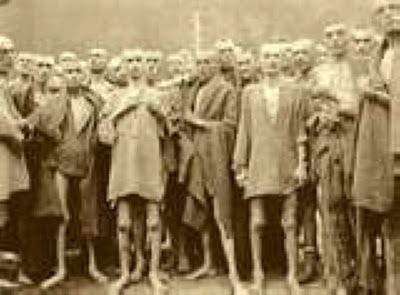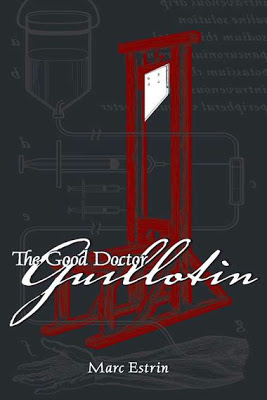
THE WHITE DOT IN THE MIDDLE OF
By Marc Estrin / The Rag Blog / February 5, 2010
The calendar offers up some provocative coincidences — provocative and tartly instructive. January 27th, for instance, has given us both Mozart’s birthday, and the liberation of Auschwitz.
Mozart and Auschwitz. Could there be two poles further apart? Two poles at the blazing core of German-speaking culture, that playing field for the possibilities of the human.
Those familiar with Mozart know that his writing is not all sweetness and light. The late works, especially, peer unflinchingly into that wildness and pain that was his life, that led him, at 35, to a pauper’s grave, whereabouts unknown. So to find the dark moments in Mozart is not hard.
One of the characters in my recent novel, The Good Doctor Guillotin, Tobias Schmidt, the German piano-maker who wound up building the first guillotines during the French Revolution, describes a concert in Paris by the 22-year old Austrian visitor in which he played a set of his variations on the bawdy folk tune “Ah je vous dirai, Maman.” (We know the melody as that of “Twinkle, Twinkle, Little Star.”) He talks about how
“in the middle of the unending C major of this trivial folk tune, Mozart had thrown himself and his listeners into a precipitous C minor variation which ripped open the pleasant, clever world, and exposed the darkest forces lurking in the background.”
Yes. Fairly standard, even in Haydn, and more to come in Beethoven. Yin and yang: the black dot in the middle of the white. High German culture — and then Auschwitz.
But then, there is the other dot — the white one in the middle of the black. The paradox is that this one can prove even more painful.
In another scene in the novel, Schmidt is accompanying Dr. Guillotin’s violin in a room in the captured king’s prison palace:
“Why are you crying?” Schmidt asked.
Guillotin had put down his violin.
“Why are you crying?” he asked his pianist.
“I’m not crying. That’s sweat,” Schmidt said, wiping away a tear.I’ll tell you why they were crying. They were crying because in the E minor violin sonata there is a moment too beautiful to play — the trio in E major, haunting, unbearably poignant and lovely.
Guillotin had gulped at the key change, started to tear up at the first rising sixth of the theme, and by the repeat of the first phrase had to lower his instrument.
Schmidt was crying because — like the C minor moment in the Ah, vous dirais-je variations he had heard Mozart play — this moment, too, seemed to open a trapdoor revealing all those lurking dark forces, then shut it quickly again — but in reverse and inside out. Here it was a trapdoor not into darkness but into a universe of light, of the possible, of all that could be but isn’t.
They were crying because they understood this: That such a world is hidden from us, unattainable, glimpsed only in Mozart’s cruel caress. A dark E minor minuet: the dance par excellence of the aristocracy. Grace, beauty, decorum. Delicate but controlled and controlling. And then the intolerable knife thrust of the exquisite trio — revealing the old order for all its implications, its unsuspected possibilities of disaster.
Is that what we’re crying about?” Guillotin demanded. “An exposé of the old order? I thought we knew that. I thought we were trying a new order.”
“That’s what I, at least, am crying about,” the piano-maker said. “It’s not the ghastly court and the canting nobility I’m mourning, it’s the stability and structure, the placidity and contentment, the state of grace they would pretend. I’m crying because I understand the loss. I fear it; I fear such transience, fear mortality—in this context of most beauty. I’m crying because we will now have to face the great trembling — at hand — and inescapable.”
Guillotin dried his eyes, wiped the rosin off his strings, and, taking this cue, Schmidt closed the piano, an instrument he had built for the music room of the Tuileries palace.
The awfulness of beauty. The unbearable face of unattained, unattainable possibility. The white dot in the middle.
I wonder if those who are having so much difficulty giving up their dreams of the Obama-they-would-have are paralyzed by the same awful contrast between the dot and its matrix.

[Marc Estrin is a writer and activist, living in Burlington, Vermont. His novels, Insect Dreams, The Half Life of Gregor Samsa, The Education of Arnold Hitler, Golem Song, and The Lamentations of Julius Marantz have won critical acclaim. His memoir, Rehearsing With Gods: Photographs and Essays on the Bread & Puppet Theater (with Ron Simon, photographer) won a 2004 theater book of the year award. He is currently working on a novel about the dead Tchaikovsky.]
- Find The Good Doctor Guillotin by Marc Estrin on Amazon.com.


















Marc, thanks for writing so tenderly about the moment of beauty and its poignance and possibility. Hope you’re having a good Burlington winter.